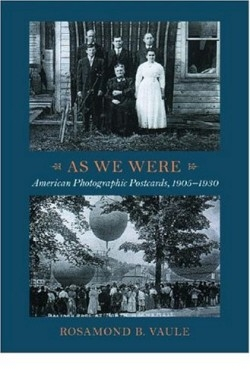As We Were
American Photographic Postcards 905-1930
One of the postcards in this meticulously researched book shows a streetcar riot in Muskegon, Michigan on August 5, 1919, where some of the streetcars are overturned. The postcard’s message reads, “Had a serious riot here Tues. eve - and about all streetcars demolished so we have no cars running now, due to raising the fare to 7c.”
Many years after her grandfather’s death, the author discovered a cache of photographic postcards that he had collected. They were a record of her father’s childhood in a small Ohio town; all but one were by unknown photographers.
Vaule then began collecting what was termed “real photos” and has selected for this volume 220 of them from all over the country. She examines their role in depicting American history and popular culture of that era. They portray a society in transition from predominantly rural to urban, from agrarian-based livelihoods to the many occupations required to sustain urban and suburban life. Vaule writes that they convey the continuing American theme of “the land of opportunity and upward mobility.”
In discussing the evolution of early photography, Vaule explains that photographers needed not only extensive and expensive materials and equipment, but also sufficient knowledge of optics and chemistry to put them to use. Time-sensitive laboratory work was necessary, since wet plates had to be coated, exposed, and developed before they dried.
New postal regulations, innovations in mass printing processes, tourism and curiosity about distant places, convenience, and a desire for inexpensive communications all helped promote the sending and collecting of postcards. Vaule believes that at a time when many adults had limited schooling, the postcard’s brevity appealed to them.
Vaule writes that among the best postcards she found are those with views of towns, resorts, and popular sites. Portraiture, she says, is one of the richest and most appealing genres of postcard photography, and her book contains many of these, usually portraying families—people standing erect, staring straight at the camera, and rarely smiling.
The postcards’ personal messages are displayed, some in pencil, some in pen. Some make no allusion to the photo contents; some seem absurdly ill-suited to the image; some disparage the likeness, yet send it and hope for one in return; and some speak proudly of who or what is in the photograph. Vaule writes that “like the images, the messages are seldom momentous, but they are personal and revealing.”
Touching and truthful, these fleeting moments frozen in time enable readers to relive the past and impel them to remember history. In both the photos and the text, Vaule vividly captures “the way we were.”
Reviewed by
George Cohen
Disclosure: This article is not an endorsement, but a review. The publisher of this book provided free copies of the book to have their book reviewed by a professional reviewer. No fee was paid by the publisher for this review. Foreword Reviews only recommends books that we love. Foreword Magazine, Inc. is disclosing this in accordance with the Federal Trade Commission’s 16 CFR, Part 255.

